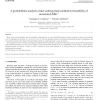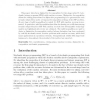156 search results - page 2 / 32 » A cutting plane method for solving linear generalized disjun... |
IPCO
2008
13 years 6 months ago
2008
Abstract. Semidefinite relaxations are known to deliver good approximations for combinatorial optimization problems like graph bisection. Using the spectral bundle method it is pos...
AUTOMATICA
2007
13 years 5 months ago
2007
ust control problems can be formulated in abstract form as convex feasibility programs, where one seeks a solution x that satisfies a set of inequalities of the form F . = {f (x,...
IOR
2010
13 years 3 months ago
2010
This paper introduces disjunctive decomposition for two-stage mixed 0-1 stochastic integer programs (SIPs) with random recourse. Disjunctive decomposition allows for cutting plane...
SIAMJO
2010
13 years 3 months ago
2010
The imposition of general disjunctions of the form “πx ≤ π0 ∨ πx ≥ π0 + 1”, where π, π0 are integer valued, is a fundamental operation in both the branch-and-bound...
IOR
2011
13 years 7 days ago
2011
We formulate a risk-averse two-stage stochastic linear programming problem in which unresolved uncertainty remains after the second stage. The objective function is formulated as ...


